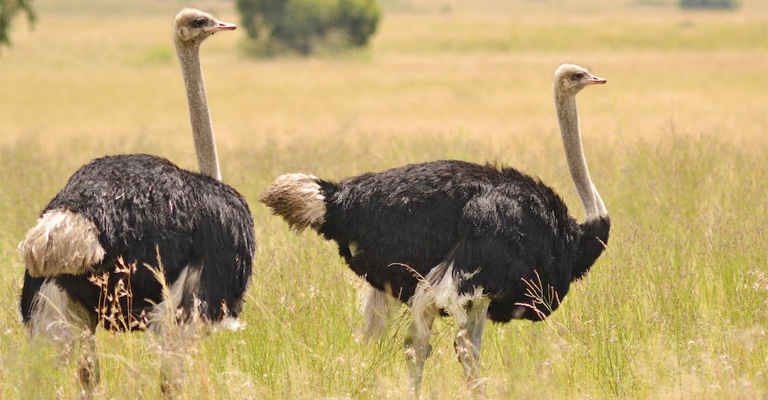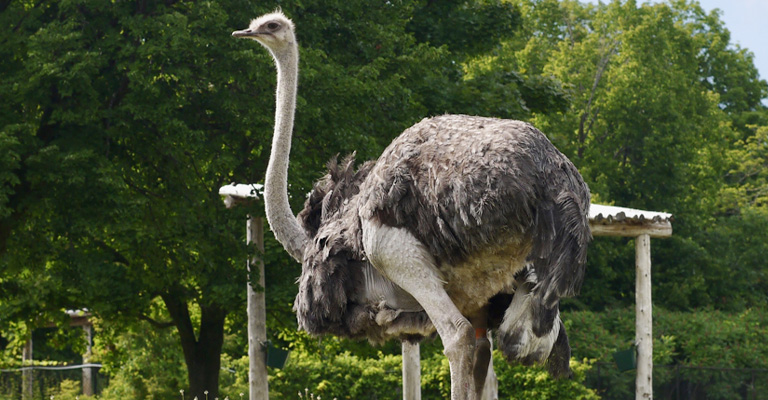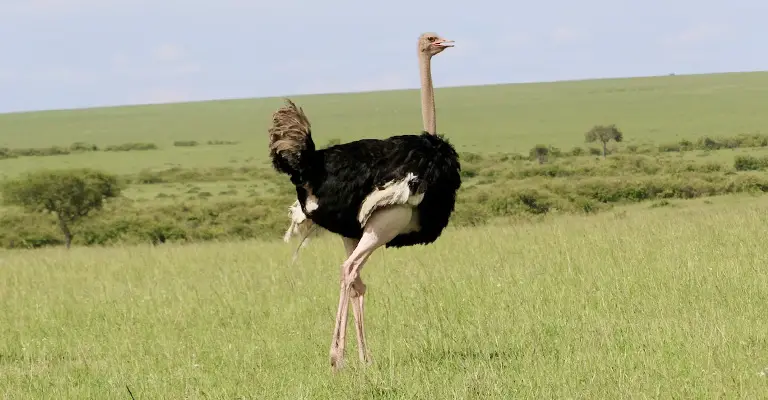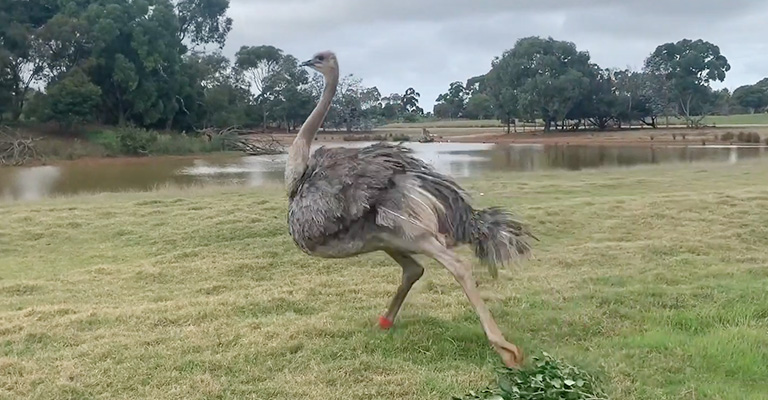In a world where the skies are dominated by a myriad of winged creatures, the ostrich stands as an intriguing exception.
With its immense size, powerful legs, and unique adaptations, this flightless giant raises the question: Why can’t ostriches fly?
Unlike their airborne counterparts, ostriches have evolved in a way that favors terrestrial prowess over aerial endeavors.
Delving into the reasons behind their grounded existence unveils a tale of adaptation, evolution, and ecological specialization that sheds light on the delicate balance of survival strategies in the natural world.

Why Can’t Ostriches Fly?
Ostriches are the largest and heaviest living birds, but they cannot fly.
There are many reasons why ostriches have lost their ability to fly, and here are some of them:
Large And Heavy Bodies
Ostriches can grow up to 9 feet tall and weigh up to 350 pounds. Their large and heavy bodies make it difficult for them to lift themselves off the ground and sustain flight.
They would need very large and powerful wings to overcome their weight, which they do not have.
Small And Weak Wings
Ostriches have the smallest wings relative to the body size of any living bird. Their wings are only about 2 feet long, and they have only 10 primary feathers and 16 secondary feathers.
Their wings are also weak and poorly developed, as they lack the muscles and bones that support flight in other birds. Their wings are not able to generate enough lift or thrust to enable flight.
Different Feather Structures

Ostriches have the largest and most numerous feathers of any living bird. However, their feathers are different from those of flying birds in terms of structure and function.
Their feathers are soft, fluffy, and loose rather than stiff, smooth, and interlocking. Their feathers help them protect their skin from the sun, insulate their body, and attract mates rather than provide aerodynamic efficiency and stability for flight.
Different Respiratory System
Ostriches have a different respiratory system from those of flying birds, which affects their ability to fly.
Flying birds have a complex respiratory system that consists of lungs, air sacs, and hollow bones, which allow them to breathe efficiently and continuously during flight.
Ostriches have a simpler respiratory system that consists of lungs and air sacs, but not hollow bones, which limit their oxygen intake and delivery during flight.
Different Skeletal System
Ostriches have a different skeletal system from those of flying birds, which affects their ability to fly. Flying birds have a light and flexible skeletal system that allows them to maneuver and balance in the air.
Ostriches have a heavy and rigid skeletal system that restricts their movement and posture on the ground. Ostriches also lack the keel bone, which is a large projection on the sternum that anchors the flight muscles in flying birds.
Different Muscular System

Ostriches have a different muscular system from those of flying birds, which affects their ability to fly. Flying birds have large and powerful muscles that control their wings and tail, which are essential for flight.
Ostriches have small and weak muscles that control their wings and tail, which are useless for flight. Ostriches also lack the supracoracoideus muscle, which is a muscle that lifts the wing in flying birds.
Adapted To Running
Ostriches have adapted to running as their main mode of locomotion rather than flying. Running is more efficient and effective for ostriches in their habitats, as they can escape predators, chase prey, and travel long distances on land.
Ostriches can run at speeds of up to 43 miles per hour, making them the fastest land animals on two legs. They use their wings to balance and steer and their legs to propel themselves forward.
Evolved From Flying Ancestors
Ostriches belong to a group of flightless birds called ratites, which also include emus, cassowaries, kiwis, and rheas. Ratites are believed to have evolved from flying ancestors that lived about 65 million years ago.
However, due to changes in climate, geography, ecology, and competition, ratites gradually lost their ability to fly over millions of years.
Ostriches are the oldest living ratites, having diverged from their closest relatives about 40 million years ago.
No Need Or Pressure To Fly
Ostriches have no need or pressure to fly in their habitats, as they can survive and thrive on land.
They have various ways to defend themselves from predators, such as running away, kicking, or hiding. They also have abundant food sources on land, such as plants, insects, lizards, snakes, rodents, and carrion.
They also have no competitors or rivals in the air, as they are the dominant animals in their habitats. Therefore, ostriches have no incentive or motivation to fly.
Do People Hunt Ostriches For Their Feathers Or Meat?

Yes, people hunt ostriches for their feathers and meat, as well as for their leather and eggs.
Ostriches are farmed worldwide, with significant industries in the Philippines and in Namibia. Ostrich leather is a lucrative commodity, and the large feathers are used as plumes for the decoration of ceremonial headgear.
Ostrich eggs have been used by humans for millennia for food, art, jewelry, and religious rituals. Ostrich meat is low in fat and cholesterol and high in protein and iron. Ostrich feathers are also used for cleaning, dusting, and making feather dusters.
However, hunting ostriches in the wild is illegal in most countries, as they are protected by law and conservation efforts. Ostriches are fascinating birds that have some unique features that make them valuable and useful for human society.
Do Ostriches Ever Fly? [5 Facts]

Ostriches are the largest and heaviest living birds, but they cannot fly. There are many reasons why ostriches have lost their ability to fly, and here are five facts about them:
Fact 1
Ostriches have small and weak wings that are not able to generate enough lift or thrust to enable flight.
Their wings are only about 2 feet long, and they have only 10 primary feathers and 16 secondary feathers. Their wings are also weak and poorly developed, as they lack the muscles and bones that support flight in other birds.
Fact 2
Ostriches have large and heavy bodies that make it difficult for them to lift themselves off the ground and sustain flight.
They can grow up to 9 feet tall and weigh up to 350 pounds. They would need very large and powerful wings to overcome their weight, which they do not have.
Fact 3
Ostriches have different feather structures from those of flying birds in terms of structure and function.
Their feathers are soft, fluffy, and loose rather than stiff, smooth, and interlocking. Their feathers help them protect their skin from the sun, insulate their body, and attract mates rather than provide aerodynamic efficiency and stability for flight.
Fact 4
Ostriches have adapted to running as their main mode of locomotion rather than flying. Running is more efficient and effective for ostriches in their habitats, as they can escape predators, chase prey, and travel long distances on land.
Ostriches can run at speeds of up to 43 miles per hour, making them the fastest land animals on two legs. They use their wings to balance and steer and their legs to propel themselves forward.
Fact 5
Ostriches belong to a group of flightless birds called ratites, which also include emus, cassowaries, kiwis, and rheas. Ratites are believed to have evolved from flying ancestors that lived about 65 million years ago.
However, due to changes in climate, geography, ecology, and competition, ratites gradually lost their ability to fly over millions of years. Ostriches are the oldest living ratites, having diverged from their closest relatives about 40 million years ago.
These are some of the facts about why ostriches cannot fly.
FAQ
Ostriches lack the necessary adaptations for flight. Their bodies are large and heavy, making it difficult to achieve the lift required for flying.
Also, their wings are relatively small and better suited for balance and maneuvering while running.
Evidence suggests that ostrich ancestors could fly millions of years ago. However, as they evolved and adapted to different environments, the benefits of flight diminished, leading to the loss of flight capabilities.
Yes, size plays a significant role. Ostriches are among the heaviest and largest birds, making it challenging for them to achieve the necessary lift-off.
Their large bodies require more energy to become airborne, which isn’t efficient given their current adaptations.
Ostriches’ wings are too small for sustained flight or gliding. However, they do use their wings for balance and stability while running.
Their wings also aid in displays, social interactions, and temperature regulation.
Different flightless birds, like penguins and emus, have similar reasons for their lack of flight: their adaptations are better suited for their environments.
These birds have evolved to thrive in various ecosystems where flight is less advantageous compared to other survival strategies.
Conclusion
Ostriches’ inability to fly is a result of a series of evolutionary trade-offs. Their adaptation to a running lifestyle, coupled with their large size and lack of the aerodynamic features typical of flying birds, has led them down a different evolutionary path.
Instead of taking to the skies, ostriches have capitalized on their powerful legs for speed and agility, which are invaluable in their open grassland habitats.
This unique choice has allowed them to excel in their own niche, demonstrating the diverse ways in which life finds its place in the intricate tapestry of nature.
The grounded existence of ostriches stands as a testament to the variety of survival strategies that have flourished in the boundless landscape of the natural world.